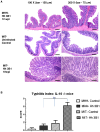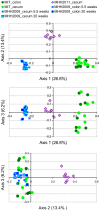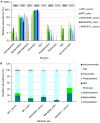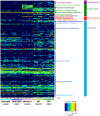Intestinal microbiota composition of interleukin-10 deficient C57BL/6J mice and susceptibility to Helicobacter hepaticus-induced colitis
- PMID: 23951007
- PMCID: PMC3739778
- DOI: 10.1371/journal.pone.0070783
Intestinal microbiota composition of interleukin-10 deficient C57BL/6J mice and susceptibility to Helicobacter hepaticus-induced colitis
Abstract
The mouse pathobiont Helicobacter hepaticus can induce typhlocolitis in interleukin-10-deficient mice, and H. hepaticus infection of immunodeficient mice is widely used as a model to study the role of pathogens and commensal bacteria in the pathogenesis of inflammatory bowel disease. C57BL/6J Il10(-/-) mice kept under specific pathogen-free conditions in two different facilities (MHH and MIT), displayed strong differences with respect to their susceptibilities to H. hepaticus-induced intestinal pathology. Mice at MIT developed robust typhlocolitis after infection with H. hepaticus, while mice at MHH developed no significant pathology after infection with the same H. hepaticus strain. We hypothesized that the intestinal microbiota might be responsible for these differences and therefore performed high resolution analysis of the intestinal microbiota composition in uninfected mice from the two facilities by deep sequencing of partial 16S rRNA amplicons. The microbiota composition differed markedly between mice from both facilities. Significant differences were also detected between two groups of MHH mice born in different years. Of the 119 operational taxonomic units (OTUs) that occurred in at least half the cecum or colon samples of at least one mouse group, 24 were only found in MIT mice, and another 13 OTUs could only be found in MHH samples. While most of the MHH-specific OTUs could only be identified to class or family level, the MIT-specific set contained OTUs identified to genus or species level, including the opportunistic pathogen, Bilophila wadsworthia. The susceptibility to H. hepaticus-induced colitis differed considerably between Il10(-/-) mice originating from the two institutions. This was associated with significant differences in microbiota composition, highlighting the importance of characterizing the intestinal microbiome when studying murine models of IBD.
Conflict of interest statement
Figures






Similar articles
-
Strain-specific colitis susceptibility in IL10-deficient mice depends on complex gut microbiota-host interactions.Inflamm Bowel Dis. 2012 May;18(5):943-54. doi: 10.1002/ibd.21895. Epub 2012 Jan 11. Inflamm Bowel Dis. 2012. PMID: 22238116
-
Helicobacter hepaticus HHGI1 is a pathogenicity island associated with typhlocolitis in B6.129-IL10 tm1Cgn mice.Microbes Infect. 2008 Jun;10(7):726-33. doi: 10.1016/j.micinf.2008.03.011. Epub 2008 Apr 4. Microbes Infect. 2008. PMID: 18538610 Free PMC article.
-
Helicobacter hepaticus-induced colitis in interleukin-10-deficient mice: cytokine requirements for the induction and maintenance of intestinal inflammation.Infect Immun. 2001 Jul;69(7):4232-41. doi: 10.1128/IAI.69.7.4232-4241.2001. Infect Immun. 2001. PMID: 11401959 Free PMC article.
-
Helicobacter hepaticus infection in mice: models for understanding lower bowel inflammation and cancer.Mucosal Immunol. 2011 Jan;4(1):22-30. doi: 10.1038/mi.2010.61. Epub 2010 Oct 13. Mucosal Immunol. 2011. PMID: 20944559 Free PMC article. Review.
-
Genetic and environmental factors shape the host response to Helicobacter hepaticus: insights into IBD pathogenesis.Curr Opin Microbiol. 2022 Feb;65:145-155. doi: 10.1016/j.mib.2021.10.012. Epub 2021 Dec 6. Curr Opin Microbiol. 2022. PMID: 34883389 Review.
Cited by
-
The development of colitis in Il10-/- mice is dependent on IL-22.Mucosal Immunol. 2020 May;13(3):493-506. doi: 10.1038/s41385-019-0252-3. Epub 2020 Jan 13. Mucosal Immunol. 2020. PMID: 31932715 Free PMC article.
-
The gut microbiota in mouse models of inflammatory bowel disease.Front Cell Infect Microbiol. 2014 Feb 28;4:28. doi: 10.3389/fcimb.2014.00028. eCollection 2014. Front Cell Infect Microbiol. 2014. PMID: 24616886 Free PMC article. Review.
-
The Microbiome in Posttraumatic Stress Disorder and Trauma-Exposed Controls: An Exploratory Study.Psychosom Med. 2017 Oct;79(8):936-946. doi: 10.1097/PSY.0000000000000512. Psychosom Med. 2017. PMID: 28700459 Free PMC article.
-
Differing Complex Microbiota Alter Disease Severity of the IL-10-/- Mouse Model of Inflammatory Bowel Disease.Front Microbiol. 2017 May 11;8:792. doi: 10.3389/fmicb.2017.00792. eCollection 2017. Front Microbiol. 2017. PMID: 28553262 Free PMC article.
-
Effect of shipping on the microbiome of donor mice used to reconstitute germ-free recipients.Gut Microbes Rep. 2024;1(1):1-8. doi: 10.1080/29933935.2024.2363858. Epub 2024 Jun 28. Gut Microbes Rep. 2024. PMID: 39328895 Free PMC article.
References
-
- Ward JM, Fox JG, Anver MR, Haines DC, George CV, et al. (1994) Chronic active hepatitis and associated liver tumors in mice caused by a persistent bacterial infection with a novel Helicobacter species. J Natl Cancer Inst 86: 1222–1227. - PubMed
-
- Boutin SR, Rogers AB, Shen Z, Fry RC, Love JA, et al. (2004) Hepatic temporal gene expression profiling in Helicobacter hepaticus-infected A/JCr mice. Toxicol Pathol 32: 678–693. - PubMed
Publication types
MeSH terms
Substances
Grants and funding
LinkOut - more resources
Full Text Sources
Other Literature Sources
Medical
Molecular Biology Databases

